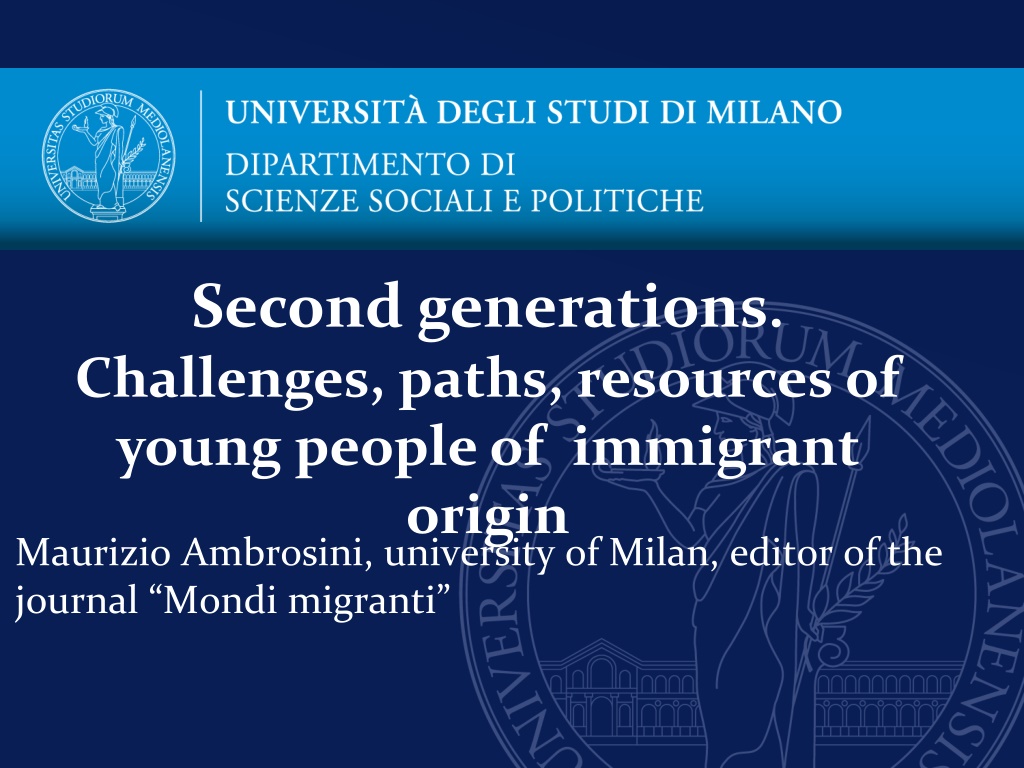Challenges and Opportunities for Second Generation Immigrant Youth in Italy
The challenges and paths faced by young people of immigrant origin in Italy are explored in this scholarly work. Issues such as social integration, citizenship, and cultural assimilation are discussed, shedding light on the experiences of children of immigrants living in Italy. The unique Italian context, including low language proficiency and precarious living conditions, adds complexity to the immigrant experience. The study also delves into intermediary structures like migrant families, highlighting the importance of familial relationships in the integration process.
Download Presentation

Please find below an Image/Link to download the presentation.
The content on the website is provided AS IS for your information and personal use only. It may not be sold, licensed, or shared on other websites without obtaining consent from the author. Download presentation by click this link. If you encounter any issues during the download, it is possible that the publisher has removed the file from their server.
E N D
Presentation Transcript
Second generations. Challenges, paths, resources of young people of immigrant origin Maurizio Ambrosini, university of Milan, editor of the journal Mondi migranti
Children of immigrants. Why are they a crucial issue? Children of immigrants: why are we so interested in their social integration? The issue of citizenship: the identity of the nation and the social order the perception of social change and the anxiety of assimilation
Who and how many are? The different profiles of the population concerned: children born here, reunited at various ages, left behind, children of mixed unions . Today minors and young people of immigrant origin living in Italy are more than one million. more than half of them were born in Italy
Some Italian peculiarities The issue of citizenship Low knowledge of Italian language in the world Recent beginning of the process Precariousness of living and housing conditions Fluidity and unpredictability of the arrivals Subordinate integration and its consequences
Between assimilation and discrimination Two big orientations: 1) Studies on attitudes and behaviours: the long wave of assimilation 2) Studies on outcomes: discrimination and its consequences The right to be similar and the right to be different
Cultural assimilation and economic integration Economic integration - + Marginal integration Selective integration - Cultural Assimilation + Apparent integration Classic linear integration
Intermediary structures: migrant families Reversal reunions and non conventional families (broken, single parents families, step-families) Research of new balances and transmission of identity Family as a dynamic space and a site of negotiation The relationship with the ethnic community and the issue of respect The reversed perception of gender issues
A research study on adolescents and families (Ismu-Caritas, 2009) Conflictual relationship Non conflictual relationship The integrated (22,6%) Youth identity Theadolescents (17,5%) Ethnic identity The rebels (30,6%) The conservatives (29,2%)
Intermediary institutions: immigrant communities Adolescents newly arrived as a group at risk Socialization of adolescents with similar people: the issue of the language, intimate communication and the perception of external society
Street gang? The research on the so called street gang : the substitution of the family and the research of support Sociability and mutual help From exclusion to pride: the reversal of the stigma Experiences on the edge
Why the issue is important Because it transforms temporary immigrations into permanent settlements Because it challenges the pattern of subordinate integration Because it challenges the (asserted) ethnic homogeneity of receiving countries Because it challenges the foundations of national identity: it demands to talk of it looking at the future and not at the past

